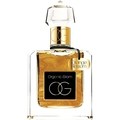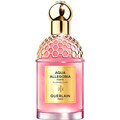Translated
Show original
Tart innocence - melancholic sensuality
When I received the first O sample with an order from Guerlain, I had never noticed Angelique Noire and therefore had no idea what this fragrance was like. I am generally skeptical when a fragrance's name suggests something angelic. For me, angels are not cute amulets. For me, angels are the projection of fearsome, powerful heavenly messengers with whom we humans must have no contact, because they are said to be dangerous and even deadly for us.
So I blind-tested Angelique Noire and noted that I found it to be an enigmatic herbal-green, slightly bitter fragrance with a peculiar sharpness that I thought was citral (also known as neral or litsea cubeba). I had perhaps also added a hint of galbabum. Underneath, I had not perceived a sweet or even gourmand vanilla, but a lovely creamy one and suspected that it could be sandalwood. It was an interesting fragrance that I liked, but it didn't grab me at first. I judged the vanilla-sandal note to be a very ingenious antagonist to the otherwise only harsh-green herbaceous main ingredient.
After a while and wearing it again, I realized that Angelique Noir created a soft envelope of fragrance around me with a soft tingling sharpness, as if made for my skin.
Then I emptied the sample. So I didn't give it any more thought, because Angelique Noir is an expensive fragrance for me and would hardly be an option for me, at best a bottling from the souk.
Then I received another O-sample from Guerlain, which I used for further testing and also called up here for the first time.
I was puzzled by the ingredients listed here, I couldn't do anything with them compared to what I perceived of Angelique Noire.
I did some research and realized that this fragrance was not Angelique but the medicinal and poisonous plant Angelica. Which I had never noticed in a perfume before, even though it was listed.
I read the reviews and I couldn't do anything with them either, because Angelique Noir is neither a vanilla scent nor a gourmand scent for me. Even after a long time, the green, slightly sharp-bitter scent remains ephemerally infused with a gentle, creamy vanilla-sandal blend.
Angelique Noire was still perceptible on my wrist shirt after 2 days of wearing it again. I couldn't layer any other fragrance with it. But I was now completely seduced by Angelique Noir and said to my husband with a sigh: "What a pity that I don't have a patron who adores this fragrance?" and received it from my husband as an Easter present,
Now Angelique Noire was in front of me and I wanted to know exactly what Daniela Andrier's inspiration was, how the ingredients are presented at Guerlain.
I didn't find an ingredient list or pyramid, just the ingredients that must be listed on every perfume and cosmetics package. Yes, I also found citral, and the usual substances I know that are also listed for other perfumes and cosmetics. I also read other chemical ingredients that mean little to me and that may also be present in natural fragrances.
However, I noticed that there are remarkably few ingredients listed on the packaging, otherwise Guerlain always has extensive lists and long terms of synthetic substances that usually mean nothing to me.
But then I found a video clip on the Guerlain website about Angelique Noire with Daniela Dandrier and Thierry Wasser. It explained that for Angelique Noire, both the parts of the plant that grow above the ground (stems, leaves, flowers) and the roots of the Angelica plant are used for the perfume. That it is a very tart, green, herbaceous and bitter fragrance that has been tamed with the softness and gentleness of vanilla. That it is very difficult to make a perfume from the angelica plant because this shell releases two completely different essences.
No other fragrances or ingredients were mentioned, nor are they listed anywhere on the Guerlain website.
Then Thierry Wasser explained what the inspiration for this ambivalent fragrance was, the associations it evokes in you/him.
But I won't presume to repeat that here. It is the inspirations and associations of Daniela Dandrier that are explained first and of Thierry Wasser;
Expressed very poetically and full of devotion and tenderness. So that it touched me very much. I listened to it three times.
Instead, I took a close look at the angelica plant on Wikipedia, read all about it and I know that at least as a child I often saw this plant. It is a large umbelliferous plant like the poisonous hemlock and especially like the giant hogweed, which is very dangerous for our human skin. In my home country there are many bodies of water, streams, ditches, canals, swampy wet areas, that's where it grows. At least that's where it grew.
Angelica also has a mild photochemical reaction that corrodes the skin, as does the very dangerous giant hogweed. It is also described that angelica is a medicinal plant that was formerly used for many ailments, pains and diseases and that it is also slightly poisonous.
And that its extract or distillate is used in herbal stomach bitters such as Boonekamp or the famous French Chartreuse.
To summarize: It is an ambivalent unique and rare fragrance. For me, it is a sensual, tender, precious fragrance. Its dark green aromatic bitterness with the soft and tender vanilla expresses the melancholy and poetry of such feelings and moments.
So I blind-tested Angelique Noire and noted that I found it to be an enigmatic herbal-green, slightly bitter fragrance with a peculiar sharpness that I thought was citral (also known as neral or litsea cubeba). I had perhaps also added a hint of galbabum. Underneath, I had not perceived a sweet or even gourmand vanilla, but a lovely creamy one and suspected that it could be sandalwood. It was an interesting fragrance that I liked, but it didn't grab me at first. I judged the vanilla-sandal note to be a very ingenious antagonist to the otherwise only harsh-green herbaceous main ingredient.
After a while and wearing it again, I realized that Angelique Noir created a soft envelope of fragrance around me with a soft tingling sharpness, as if made for my skin.
Then I emptied the sample. So I didn't give it any more thought, because Angelique Noir is an expensive fragrance for me and would hardly be an option for me, at best a bottling from the souk.
Then I received another O-sample from Guerlain, which I used for further testing and also called up here for the first time.
I was puzzled by the ingredients listed here, I couldn't do anything with them compared to what I perceived of Angelique Noire.
I did some research and realized that this fragrance was not Angelique but the medicinal and poisonous plant Angelica. Which I had never noticed in a perfume before, even though it was listed.
I read the reviews and I couldn't do anything with them either, because Angelique Noir is neither a vanilla scent nor a gourmand scent for me. Even after a long time, the green, slightly sharp-bitter scent remains ephemerally infused with a gentle, creamy vanilla-sandal blend.
Angelique Noire was still perceptible on my wrist shirt after 2 days of wearing it again. I couldn't layer any other fragrance with it. But I was now completely seduced by Angelique Noir and said to my husband with a sigh: "What a pity that I don't have a patron who adores this fragrance?" and received it from my husband as an Easter present,
Now Angelique Noire was in front of me and I wanted to know exactly what Daniela Andrier's inspiration was, how the ingredients are presented at Guerlain.
I didn't find an ingredient list or pyramid, just the ingredients that must be listed on every perfume and cosmetics package. Yes, I also found citral, and the usual substances I know that are also listed for other perfumes and cosmetics. I also read other chemical ingredients that mean little to me and that may also be present in natural fragrances.
However, I noticed that there are remarkably few ingredients listed on the packaging, otherwise Guerlain always has extensive lists and long terms of synthetic substances that usually mean nothing to me.
But then I found a video clip on the Guerlain website about Angelique Noire with Daniela Dandrier and Thierry Wasser. It explained that for Angelique Noire, both the parts of the plant that grow above the ground (stems, leaves, flowers) and the roots of the Angelica plant are used for the perfume. That it is a very tart, green, herbaceous and bitter fragrance that has been tamed with the softness and gentleness of vanilla. That it is very difficult to make a perfume from the angelica plant because this shell releases two completely different essences.
No other fragrances or ingredients were mentioned, nor are they listed anywhere on the Guerlain website.
Then Thierry Wasser explained what the inspiration for this ambivalent fragrance was, the associations it evokes in you/him.
But I won't presume to repeat that here. It is the inspirations and associations of Daniela Dandrier that are explained first and of Thierry Wasser;
Expressed very poetically and full of devotion and tenderness. So that it touched me very much. I listened to it three times.
Instead, I took a close look at the angelica plant on Wikipedia, read all about it and I know that at least as a child I often saw this plant. It is a large umbelliferous plant like the poisonous hemlock and especially like the giant hogweed, which is very dangerous for our human skin. In my home country there are many bodies of water, streams, ditches, canals, swampy wet areas, that's where it grows. At least that's where it grew.
Angelica also has a mild photochemical reaction that corrodes the skin, as does the very dangerous giant hogweed. It is also described that angelica is a medicinal plant that was formerly used for many ailments, pains and diseases and that it is also slightly poisonous.
And that its extract or distillate is used in herbal stomach bitters such as Boonekamp or the famous French Chartreuse.
To summarize: It is an ambivalent unique and rare fragrance. For me, it is a sensual, tender, precious fragrance. Its dark green aromatic bitterness with the soft and tender vanilla expresses the melancholy and poetry of such feelings and moments.
15 Comments



 Seerose
Seerose
